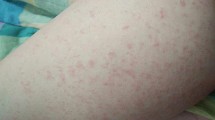Abstract
Objective: To report a case of type 1 diabetes mellitus (T1DM) in a child with phenobarbital hypersensitivity syndrome with an emphasis on the clinical presentation, diagnostic modalities and treatment options. Case summary: A 5-yr-old girl developed fever, rash and hepatic inflammation after receiving phenobarbital. Infection and connective tissue diseases were excluded and an adverse event following phenobarbital administration [anticonvulsant hypersensitivity syndrome (AHS)] was considered. Clinical manifestation was somewhat improved after systemic hydrocortisone and other antiallergic drugs were administrated. However, polyuria, polydipsia, dehydration, severe metabolic acidosis with increased anion gap and hyperglucosemia were found about 4 weeks after stopping phenobarbital. Increased blood ketone and glycosylated hemoglobin (HbA1c), and decreased blood insulin and C-peptide confirmed the diagnosis of T1DM. Insulin was used and γ-immunoglobulin was administered on the 25th day after admission. Since then, clinical symptoms and signs improved significantly and the patient was discharged on the 45th day after admission. Post-discharge course was uneventful and the patient is well with sequential HbA1c of 7.3% 1 month after discharge. Conclusions: AHS should be suspected in patients who develop unexplained systemic manifestations following exposure to aromatic antiepileptics, including phenobarbital. The timely recognition and treatment with corticosteroids and immunoglobulin is required and useful.The potential damage of β-cells should be considered in patients with AHS.
Similar content being viewed by others
References
Vittorio CC, Muglia JJ. Anticonvulsant hypersensitivity syndrome. Arch Intern Med 1995, 155: 2285–90.
Knowles SR, Shapiro LE, Shear NH. Anticonvulsant hypersensitivity syndrome: incidence, prevention and management. Drug Saf 1999, 21: 489–501.
Bessmertny O, Hatton RC, Gonzalez-Peralta RP. Antiepileptic hypersensitivity syndrome in children. Ann Pharmacother 2001, 35: 533–8.
Zaidi AN. Anticonvulsant hypersensitivity syndrome leading to reversible myocarditis. Can J Clin Pharmacol 2005, 12: e33–40.
Yamada N, Kaneko K, Saito Y, Tatsuno I. Anticonvulsant hypersensitivity syndrome with marked eosinophilia in treatment of diabetic neuropathy. Diabetes Care 2002, 25: 1099–100.
Dendukuri N, Blais L, LeLorier J. Inhaled corticosteroids and the risk of diabetes among the elderly. Br J Clin Pharmacol 2002, 54: 59–64.
Panthakalam S, Bhatnagar D, Klimiuk P. The prevalence and management of hyperglycaemia in patients with rheumatoid arthritis on corticosteroid therapy. Scott Med J 2004, 49: 139–41.
Sekine N, Motokura T, Oki T, et al. Rapid loss of insulin secretion in a patient with fulminant type 1 diabetes mellitus and carbamazepine hypersensitivity syndrome. JAMA 2001, 285: 1153–4.
Hashizume H, Takigawa M, Tokura Y. Characterization of drug-specific T cells in phenobarbital-induced eruption. J Immunol 2002, 168: 5359–68.
Chiappini E, Peruzzi M, Galli L, Calabri G, De Martino M. Evidence for a T-lymphocyte dependent mechanism involving proinflammatory cytokines in anticonvulsant hypersensitivity syndrome: a case report. Int J Immunopathol Pharmacol 2002, 15: 239–42.
Bavdekar SB, Muranjan MN, Gogtay NJ, Kantharia V, Kshirsagar NA. Anticonvulsant hypersensitivity syndrome: lymphocyte toxicity assay for the confirmation of diagnosis and risk assessment. Ann Pharmacother 2004, 38: 1648–50.
Rathmann S, Rajasalu T, Rosinger S, et al. Preproinsulin-Specific CD8+ T Cells Secrete IFNgamma in human type 1 diabetes. Ann N Y Acad Sci 2004, 1037: 22–5.
Skarsvik S, Ludvigsson J, Vaarala O. Aberrant regulation of interleukin-12 receptor beta2 chain on type 1 cytokinestimulated T lymphocytes in type 1 diabetes. Immunology 2005, 114: 287–93.
Mahatma M, Haponik EF, Nelson S, Lopez A, Summer WR. Phenytoin-induced acute respiratory failure with pulmonary eosinophilia. Am J Med 1989, 87: 93–4.
Shear NH, Spielberg SP. Anticonvulsant hypersensitivity syndrome: in vitro assessment of risk. J Clin Invest 1988, 82: 1826–32.
Author information
Authors and Affiliations
Corresponding author
Rights and permissions
About this article
Cite this article
Zou, C.C., Liang, L. & Fu, J.F. Type 1 diabetes mellitus in a child with phenobarbital hypersensitivity syndrome. J Endocrinol Invest 31, 360–363 (2008). https://doi.org/10.1007/BF03346371
Accepted:
Published:
Issue Date:
DOI: https://doi.org/10.1007/BF03346371



